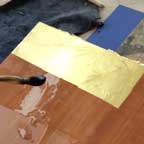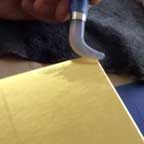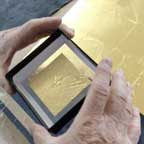what can i use to seal gold leaf
Introduction to Gilding with Gold Foliage

Gilding is the awarding of golden, silver, or other, leaf to a surface. Information technology tin can be as simple as adding touches of gold to a painting, table ornament, or to a bloom. Or it tin exist equally complicated as covering a baroque movie frame, a statue, or a country house dome in gold leaf. Regardless of the projection, the bones process is the same. Adhesive is practical to a clean and smooth surface of the item being aureate. The gilded leaf is and so pressed on to the adhesive, and the excess leaf is brushed off.
Surface Preparation
As with painting, surface preparation is important. A make clean shine surface works best. Because the golden leaf is very very thin, any imperfections in the surface will show. Only like painting over a crack in a wall, the scissure volition withal show after information technology has been painted. The surface preparation will differ depending on the base fabric. Woods, metallic and glass are the about common.
For forest, it is best to prime and seal the wood. Our Base of operations Glaze Primer Sealer is not bad for this purpose. Depending on the roughness or porosity of the wood, you lot may need multiple coats. After each glaze is applied, the surface should be sanded to go far equally polish as possible. After the final coat is sanded with a very fine sandpaper, be sure to remove whatsoever remaining the dust or other particles. Yellow Basecoat will help hide pocket-size flaws and mistakes when gilding with gold. Carmine Basecoat will alter the color tone just a bit. Grayness Basecoat is mostly used with silverish, palladium, or other white metals.
When gilding a metal object, the surface needs to be make clean and smooth. Many gilders use shellac as the base glaze, equally information technology is a wonderful sealer. The surface should be lightly sanded and clean to permit the shellac to adhere properly. One time the shellac is applied and dry, you can lightly sand with a very fine sandpaper and and so apply the gilding size.
Oil Gilding on Wood or Metal
For wood, metal, plastic or other items being gilded, you can use the size afterwards your base coat has been applied, sanded and cleaned. For modest projects, it is best to employ Quick Size, which should be applied very sparse. Some gilders utilise the size with a brush and use small foam roller to remove almost of it.
Data and instructions for using Oil Base Size can be found here.

H2o Gilding on Forest
Water gilding is dissimilar than oil gilding, requiring boosted preparation. But as with oil gilding, the surface should be as clean and shine equally possible.
Gesso, which is fabricated from Rabbit Skin Glue (RSG) and very finely ground calcium carbonate (whiting), is applied to the surface, commonly in 4 to vi coats, which are then sanded with fine sand paper when dry. After the final coat of gesso has dried, several coats of clay bole mixed with Rabbit Skin Mucilage are applied on peak. One time the clay bole has dried and been sanded smoothen, the surface is ready for the gilded leaf to be applied.

Clean, or preferably distilled, water is 'painted' where the leafage volition be applied, activating the agglutinative backdrop of the Rabbit Peel Glue in the clay bole. The golden is placed on the surface with a gilders tip, where it will be pulled on to the surface.
Every bit the excess water drains off and the surface dries, the gilt leafage volition be come up brilliant and beautiful. Using a Gilders Dusting Oval Mop, the excess gold leaf is removed, and if desired, the surface tin can be polished using an agate burnisher.

H2o Gilding on Drinking glass
Water gilding on glass is an art that produces unique and beautiful works of art. Using a cleaner such every bit Bon Ami, the glass should be completely cleaned and complimentary of clay, contaminants, grit and oil, including oil left by fingerprints.
The glass is placed at an bending, and gelatin glue is applied with a mop, to what volition eventually get the dorsum side of the slice. Working from the pinnacle edge, the gold is then applied using a gilders tip, or a Thorn Tip.
As the water drains and the gold dries, it volition become bright and shiny. Backlog golden tin be gently removed with a Gilders Dusting Oval Mop.
When completely dry, the glass can exist silk screened, or painted. Later the paint has completely stale, a Gilders Removal Brush can be used to gently remove the backlog golden leafage, leaving just the leaf protected by the paint. When looking at the forepart side, merely the gold that is backed upwards by the silk screen ink or paint can exist seen. Additional painting or silk screening tin can be done to create a unique piece of art.
Sealing Your Gilding Projection
Sealing will forbid oxidation and color change in leaf that does not accept a high gold content. Information technology is especially of import when using silverish leaf, copper foliage, imitation leafage, 12k and 18k foliage. For indoor utilize, 22k and college does not need to be sealed.
Topcoat Sealer tin can be applied to your projection using a brush, roller, or by spraying.
If sealing a project to protect from damage or handing, acrylic urethane or a clear automotive paint is a meliorate option.
Sealing gold or silver will result in some loss of effulgence and shininess.
Source: https://www.goldenleafproducts.com/info-introduction-to-gilding-with-gold-leaf.html
Post a Comment for "what can i use to seal gold leaf"